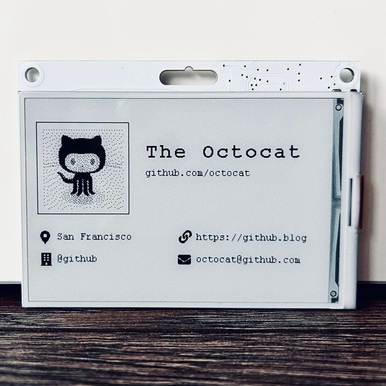In a way, an e-paper display makes an excellent foundation for a reprogrammable RFID card. The display only needs power during a refresh, and 125 kHz RFID tags are passive in the sense that the power for the RFID transaction comes from the reader itself. [Georgi Gerganov] has put those together in the GGtag, an open-source project for a 3.52″ e-paper badge with a trick or two up its sleeve.
 One clever function is that it is programmable with sound, a feature built off another project of [Georgi]’s called ggwave, a data-to-sound (and vice-versa) framework that has been ported to just about every hardware platform one cares to imagine — including mobile phones — and can reliably send data through the air.
One clever function is that it is programmable with sound, a feature built off another project of [Georgi]’s called ggwave, a data-to-sound (and vice-versa) framework that has been ported to just about every hardware platform one cares to imagine — including mobile phones — and can reliably send data through the air.
Transmitting data over sound is limited in throughput but has a number of advantages, not least of which is the huge range of compatible devices. There’s a web-based tool for programming the GGtag with sound available at ggtag.io that will give you a preview and let you hear how it works. The data encoding method gives transmissions a charming beep-boop quality that’s a bit reminiscent of an analog modem handshake. GGtag can also be programmed over USB serial, a faster (but somewhat less exciting) option.
The project’s GitHub repository contains GGtag’s code and technical details, and the CrowdSupply project is in the works for anyone who would prefer to buy one once they become available.

















Data to sound and back to data.
I had a modem that did that 30 years ago.
Broadcasting audio makes it easy to program multiple devices, but it also makes abuse very easy.
What about programming 5 devices with message X and programming 5 devices with message Y? How do you make sure the first 5 devices are not overwritten by the second message?
One way to prevent this would be to allow audio programming only once. If reprogramming is needed, then USB would have to be used.
Audio programming is a nice gimmick, but personally I think that a device with NFC instead of audio programming has more use cases.
That’s how these tags work. You have to flip the programming switch from ‘usb’ to ‘batt’, and they only automatically start listening if not programmed before, otherwise you have to hit a button.
When in ‘usb’ mode they don’t listen at all and don’t use/need a battery.
You need some kind of addressing if you want to reliably update individual targets by broadcasting sound or whatever. If addresses are assigned in a clever way instead of randomly, bandwidth needs can be drastically reduced. This was invented more than three decades ago: pay TV subscription management.
Will the transducer do rx & tx?
Anyone remember the Timex Datalink watch back in 1996ish? It was programmed by showing white lines on your monitor (it had some weird ir camera sensor)
Yes! LGR on Youtube tried to get one to work. I don’t remember much success, but it was a neat idea.
My boss had one of those and I had similar results trying to get it to sync for him. Fwiw, it did sync a few times. I had a Casio Databank for the longest time. No sync but a wonderful watch for the time :)
I thought that sounded familiar: article from 5 days ago: https://hackaday.com/2023/07/18/modern-software-brings-back-the-timex-datalink/